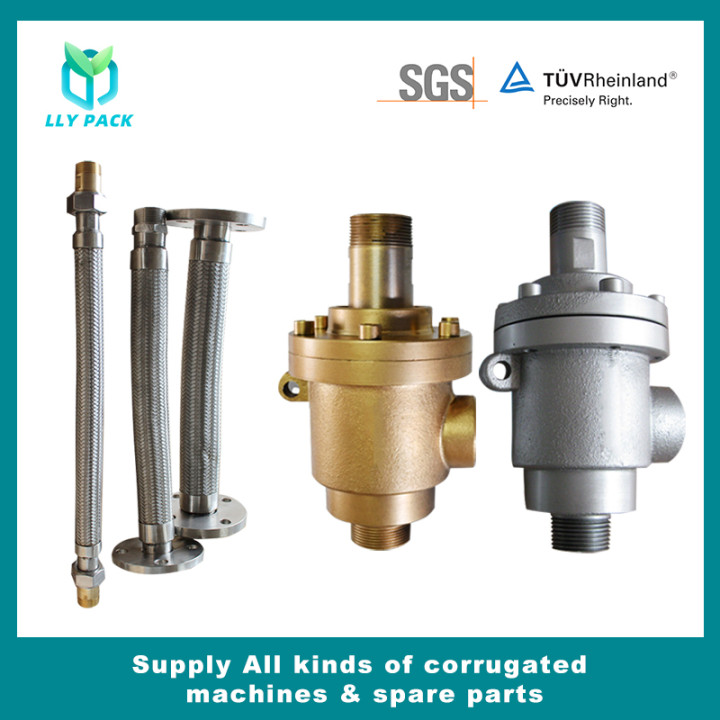Under normal circumstances, the corrugated cardboard rolled by a single-faced corrugator should meet the national standards for its height and the number of turns per 300mm length. If you use Silicon Valley as the origin of the coordinate system, the shape of the cocoon should be symmetrical, as if the alternating-current sine wave is smooth and smooth, and the cocoon height is equally lossless. However, various forms of defects are often encountered in production practices and affect the quality of corrugated boxes.
Some rickets are relatively regular, easy to analyze, and facilitate the use of appropriate improvement measures. Some of them are more difficult to rule out. Comrade Chen Qianjun and other editors of the book "Corrugated carton manufacturing and equipment" and relevant packaging technical information are all well-documented studies, this article is not repeated. However, the local collapse of corrugated paperboards makes it difficult to remove them and takes more time. In this brief analysis, it is intended to explore the most effective ways of elimination by exploring exchanges.
First, the characteristics of local collapse of corrugated cardboard and the impact on the quality of products Corrugated cardboard local collapse features:
First, collapse area changes greatly, as little as a few square centimeters, as much as thousands of square centimeters;
The second is that there is periodic collapse, and along the direction of the single-sided machine, there is a cyclical but not identical collapse on the corrugated board;
The third is that the area of collapsing is small along the middle of the corrugation;
Fourth, there is a significant degumming within the collapse area, and the thickness is only 30% of the corresponding standard thickness.
In mass production, the existence of such local collapse defects will affect the quality of the product, resulting in a large number of secondary waste products, resulting in a substantial increase in manufacturing costs, the company suffered. Such a three-layer, five-layer or seven-layer corrugated cardboard will inevitably produce a debonded area whose sum is greater than the national standard 20cm2/m2, the side pressure strength is greatly reduced, the thickness of the cardboard is lower than the national standard, the printed pattern is real and the spotted, the text is blurred, etc. The secondary waste products seriously affect the overall quality of the carton products.
Second, the main reasons for the collapse of the collapse of this type of collapse defects often appear in the guide jaw type single-sided machine production of corrugated cardboard, the main reasons:
(1) The gap between the arc radius of the guide jaw working face and the outer diameter of the lower corrugating roller is too large. As the following corrugation roller peaks have been worn to reduce the outer diameter, or the lower corrugated roller type has undergone repeated grinding, the outer diameter has been reduced, and the original guide jaws are still used, and the gap is necessarily excessive.
(2) The installation position of the guide jaw is not proper, and the clearance between the arc of the working surface of the guide jaw and the outer diameter of the lower corrugating roll is inconsistent. If the guide jaw is not installed properly, the gap between the upper end or the lower end of the guide jaw and the lower corrugating roller is too large and is far away from the pressure roller, so that the working surface does not function as a paper guide.
(3) The guide jaws have been partially worn during use, and part of the working surface cannot guide the paper normally.
From the rational analysis, the corrugated base paper is subjected to the centrifugal force generated by the operation of the corrugating roller and the dispersed moisture after baking in the single-faced corrugator rolling process, once it passes through the tiled bearing point (upper and lower corrugating roll tooth meshing point). The effect of air pressure will cause the formed corrugated paper to change its shape from the surface of the corrugating roller. At this time, the formed corrugated paper is supported by the guide claws and tightly adhered to the surface of the lower corrugating roller.
If the gap between the arc radius of the guide jaw working face and the outer diameter of the lower corrugating roller is too large or inconsistent (except where the glue is applied), the paper guiding function will not play, and the corrugated paper will be free in the radial direction. When the corrugated roller and the pressure roller are pressed during operation, the misaligned corrugated cardboard shape is pressed by the peak of the lower corrugating roller, which makes the corrugated paper coated with glue. The peaks are irregularly bonded to the inner (clip) paper to form a local collapse of the single-sided corrugated cardboard. Therefore, in the normal case of tile roller, to solve the local collapse of corrugated cardboard, the key is to make the gap between the guide jaw working face and the outer diameter of the lower corrugating roller reasonable and consistent.
Third, to eliminate the collapse of the first method to measure or check the guide claw face arc radius and the outer diameter of the lower corrugated roller is matched. If there is too much normal wear in the guide jaws, replace the guide jaws immediately. When the corrugation type of the lower corrugating roller undergoes repeated grinding and the outer diameter is reduced or the peak of the lower corrugating roll is significantly worn to reduce the outer diameter, the arc radius of the guide jaw working surface is reworked according to the reduction of the outer diameter of the lower corrugating roll.
In practice, we realized the preparation of the guide jaw radius: guide claw working surface arc radius = the actual diameter of the lower corrugating roller ÷ 2+ (1.5 ~ 1.9) × corrugated paper thickness, which E-type draw 1.5, B-type pick 1.6, C-type picking 1.8, A-type picking 1.9, in order to facilitate the wedge guide, the radius of the arc 10 ~ 20mm above the working surface of the claw can add 0.2 to 0.4mm. Followed by the installation position of the guide jaw is appropriate, the matching gap between the arc radius of the guide jaw working face and the outer diameter of the lower corrugating roller should be controlled according to the 楞 type (1.5~1.9) × corrugated paper thickness, and it should be adjusted to the upper and lower gap The plane of the guide jaws should be perpendicular to the axis of the lower corrugating roller.
The second is to check whether the two ends of the guide jaw are appropriate, whether the upper and lower ends can withstand, and observe whether the supporting corrugated paper function is normal, if there is any error, it should be adjusted, ground or remanufactured. Corrugated rollers and guide jaws have adhered materials on the work surface, which will also affect normal paper guides and should be promptly cleaned. Also need to exclude the non-parallel between the corrugated, low temperature, corrugated paper moisture and other factors.
EnglishEspañolPortuguêsDeutschहिंदी日本語ខ្មែរNederlandsالعربية한국어मराठीMalagasyItalianoPolskiSvenskaελληνικάPусскийภาษาไทยTürkShqipMagyarViệtSamoaМонголMaltiIndonesia FrançaisMelayuҚазақшаYorùbáবাঙালিעִברִיתGàidhligSomaliEesti keelKreyòl Ayisyennorskčeštinaفارسیతెలుగుမြန်မာBosanskiMaoriქართულიRomânăбеларускіУкраїнськаతమిళGaeilgeSuomalainenپښتوລາວհայերենSlovenščinaFilipinoO'zbekÍslenskaייִדישLatviešuGalegoFryskनेपालीKurdîCatalàбългарскиHawaiianHrvatskiਪੰਜਾਬੀWong JawaKiswahililëtzebuergeschisiXhosaEuskalSundaZuluગુજરાતીТоҷикӣ
- Huis
- Over ons
-
Product List
- Golflijn
- Gegolfde machine >
-
Golde machine -reserveonderdelen >
- Roterend gewricht
- Kam voor Slitter Scorer
- Remblokken
- Diafragmpomp voor lijm
- Afvalpapierstripper
- Uitbreiding
- Flexibele metalen slang
- Slijpschijf
- Tape voor splicer
- Gegolfde roller
- Slijpmes
- Overheadbrug tractieriem
- Zonnescherm
- Transportband
- NC snijmes
- Stoomval
- Pneumatische cilinders
- Pneumatische rem
- Luchtboelveer
- Waterring vacuümpomp
- Golfmachines smeermiddel
- Rubberen spacer
- Titanium-vergulde spacer
- Flexo printer slotter
- Flexo -printermachine >
-
Printer -reserveonderdelen >
- koperen plaat
- Afdrukplaatrek
- ARO-pomp
- Stalen en koperen borstel
- Inktfilter
- Dokterbladen
- ANVIL COVER
- Slotting mes
- Vezelband
- Hangend frame
- Huisdier pre-strip met film
- R en bak printing kussen
- Voedingswiel
- Eénrichtingskleurig
- Rotary Die Board
- Enkele diafragmapomp
- Inktkanaal eindblok
- Rubberen diafragma
- Duckbill -klep
- Magnetische koppelingsrem
- Hangende groove strip
- Verpakkingsmachine >
- Kartonmachine >
- Kartonnen machineonderdelen >
- Dubbele faceriemen
- Stiksels lijmensysteem >
- Kartonnen snijmes >
- Wolfraamstalen mes >
- Slijpschijf
- Afvalstripper
- Verpakkingsmachine mes >
- Pre-press apparatuur >
-
Industrieel snijmes >
- Tegel Circular Saw Blade
- Metaal snijden zaagblad
- Houtsnijzaagblad
- Voedsel snijden zaagmes
- Vezelsnijmes
- Chipperblad
- Buigvorm
- Blade voor groentesnijdende machine
- Stalen dun mes
- Tsukatani Die snijdende mes
- Printer Die Cut Blade
- Masker machineblader
- Slitter Rewinder Blade
- TMR -mes
- Tabakscirculaire mes
- Roll Shear Blade
- Gekarteld mes voor verpakkingsmachine
- Papier snijdende band mes
- Dokter mes
- Ronde mes
- Three Holes Blade
- Keramisch mes
- Bandmesmes voor stof
- Bandmesmes voor sponsschuim
- Bandmesmes voor splijten machine
- Bandmesmes voor papier
- Meshouder
- Industrieel snijmes
- Freeskutter
- Hoekmolen
- Shredderblad
- V Grooving mes
- Elektrische schaar
- CNC Machine Blade & Tools
- Voedselverwerking mes
- Nieuws
- video
- Contactgegevens
- Klik Hier om onderzoek te sturen










